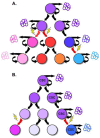The role of colorectal cancer stem cells in metastatic disease and therapeutic response
- PMID: 21318087
- PMCID: PMC3036171
- DOI: 10.3390/cancers3010319
The role of colorectal cancer stem cells in metastatic disease and therapeutic response
Abstract
Colorectal cancer is the third-leading cause of cancer related mortality in the United States. The intricate molecular mechanisms involved in the regenerative process of the normal intestine and the identity of putative somatic intestinal stem cells have become clear. In parallel with this, experiment evidence has emerged supporting the century old hypothesis that solid tumor initiation, progression, chemoresistance and recurrence is the result of a small population of cancer cells with self-renewal and pluripotency capabilities. These "cancer stem cells" (CSCs) present a unique opportunity to better understand the biology of solid tumors in general, as well as targets for future therapeutics. In this review, we will summarize the current understanding of intestinal stem cell biology and translate it to colorectal CSCs to provide a basis for understanding chemoresistance, cancer recurrence and metastasis. A more complete understanding of the biology of colorectal CSCs will translate into the development of better chemotherapeutic and biological agents for the treatment of colorectal cancer.
Figures




Similar articles
-
An overview of the role of cancer stem cells in spine tumors with a special focus on chordoma.World J Stem Cells. 2014 Jan 26;6(1):53-64. doi: 10.4252/wjsc.v6.i1.53. World J Stem Cells. 2014. PMID: 24567788 Free PMC article. Review.
-
The role of microRNAs in the regulation of cancer stem cells.Front Genet. 2014 Jan 3;4:295. doi: 10.3389/fgene.2013.00295. Front Genet. 2014. PMID: 24427168 Free PMC article. Review.
-
The shifting paradigm of colorectal cancer treatment: a look into emerging cancer stem cell-directed therapeutics to lead the charge toward complete remission.Expert Opin Biol Ther. 2021 Oct;21(10):1335-1345. doi: 10.1080/14712598.2021.1929167. Epub 2021 May 24. Expert Opin Biol Ther. 2021. PMID: 33977849 Free PMC article. Review.
-
Regulation of colon cancer recurrence and development of therapeutic strategies.World J Gastrointest Pathophysiol. 2012 Feb 15;3(1):1-9. doi: 10.4291/wjgp.v3.i1.1. World J Gastrointest Pathophysiol. 2012. PMID: 22368781 Free PMC article.
-
Cancer stem cells in prostate cancer chemoresistance.Curr Cancer Drug Targets. 2014;14(3):225-40. doi: 10.2174/1568009614666140328152459. Curr Cancer Drug Targets. 2014. PMID: 24720286
Cited by
-
c-Myc maintains the self-renewal and chemoresistance properties of colon cancer stem cells.Oncol Lett. 2019 May;17(5):4487-4493. doi: 10.3892/ol.2019.10081. Epub 2019 Feb 28. Oncol Lett. 2019. PMID: 30944638 Free PMC article.
-
A concise review on miRNAs as regulators of colon cancer stem cells and associated signalling pathways.Clin Transl Oncol. 2023 Dec;25(12):3345-3356. doi: 10.1007/s12094-023-03200-x. Epub 2023 Apr 22. Clin Transl Oncol. 2023. PMID: 37086351 Review.
-
Signaling in colon cancer stem cells.J Mol Signal. 2012 Aug 6;7(1):11. doi: 10.1186/1750-2187-7-11. J Mol Signal. 2012. PMID: 22866952 Free PMC article.
-
Cancer stem cell and stromal microenvironment.Ochsner J. 2013 Spring;13(1):109-18. Ochsner J. 2013. PMID: 23531695 Free PMC article.
-
Dll1+ secretory progenitor cells revert to stem cells upon crypt damage.Nat Cell Biol. 2012 Oct;14(10):1099-1104. doi: 10.1038/ncb2581. Epub 2012 Sep 23. Nat Cell Biol. 2012. PMID: 23000963 Free PMC article.
References
-
- Black C.E., Ogle R.S. Influence of local acidification of tissue bordering cancerous growths; with special reference to the eosinophil, the paneth cell and the acidophilic plasma cell. Arch. Pathol. 1948;46:107–118. - PubMed
-
- Lipkin M. Cell replication in the gastrointestinal tract of man. Gastroenterology. 1965;48:616–624. - PubMed
-
- Cheng H., Leblond C.P. Origin, differentiation and renewal of the four main epithelial cell types in the mouse small intestine. V. Unitarian theory of the origin of the four epithelial cell types. Am. J. Anat. 1974;141:537–561. - PubMed
-
- Cheng H., Leblond C.P. Origin, differentiation and renewal of the four main epithelial cell types in the mouse small intestine. I. Columnar cell. Am. J. Anat. 1974;141:461–479. - PubMed
-
- Cheng H., Leblond C.P. Origin, differentiation and renewal of the four main epithelial cell types in the mouse small intestine. III. Entero-endocrine cells. Am. J. Anat. 1974;141:503–519. - PubMed
Grants and funding
LinkOut - more resources
Full Text Sources
